31 October 2007
Abbaye Saint-Joseph de Clairval

The Abbey and surrounding village
About sixty kilometers north of Dijon city center sits the Benedictine Abbey of St. Joseph of Clairval in Flavigny. It is a traditional community celebrating Mass according to the 1962 rite. The monastery was founded in 1976, although the village had had a Benedictine Abbey since the 7th century, up until it was closed during the Revolution.

Sint Unum: Coat of Arms of the Founding Abbot
In 1700, the Marquis de Souhey built a chateau in Flavigny, with extensive grounds and a terraced garden. After his death, the home went to various owners, until 1829, when it was bought by Ursulines, who added various wings to the chateau. in 1906, France issued a decree of expulsion, driving out all religious orders. It afterwards became the seat of the minor diocesan seminary. It was during World War II that the last of the construction was completed. The current community moved in in 1976, and proceeded to renovate the grounds, including the conventual church, finished and solemnly blessed in 1979.
The community received canonical recognition as a Benedictine monastery of diocesan right in 1988. The monastery was raised to the rank of abbey in 1992 at the request of the Holy See. The current community numbers around fifty members.

Inner Courtyard

Blessed Charles de Foucauld

Parlor Courtyard

Inner Courtyard in Snow

Entry to the Sanctuary, with St. Joseph standing sentinel

The Sanctuary

The Altar

Crux sacra sit mihi lux! Nunquam draco sit mihi dux!

Twelfth Station of the Via Dolorosa

Close-up of Stall

Our Lady of the Sacred Heart

St. Joseph Oratory

Staircase to the Tribune

St. Angela Chapel

St. Augustine, in the St. Angela Chapel

The Virgin's Garden

Eighteenth Century Terraces and Vegetable Garden

St. Gabriel

The Hedge at Dawn

Hedge Cross in Winter
29 October 2007
I found an old article about my parish that is most encouraging reading concerning the positive effects of the Traditional Latin Mass. Fr. Zuhlsdorf comments on it here.
Quotation of the Day
Indeed, the true friends of the people are neither revolutionaries, nor innovators: they are traditionalists.
--Pope St. Pius X
--Pope St. Pius X
SanctaMissa.org
 Online Tutorial for priests on the Traditional Latin Mass
Online Tutorial for priests on the Traditional Latin MassWith the Motu Proprio, this online resource will come in handy for all diocesan priests who wish to learn how to celebrate the Mass according to the 1962 Roman Missal. It includes sample liturgies with videos, and audio recordings of the Latin text, with tutorials on how to say Low Mass, Requiem Masses, and the Missae Cantata, Solemnis, and Pontificalis. Tutorials are also included, with videos, on sacred music. (The rubrics are translated by Fr. Dennis Duvelius, the priest who baptized my children.)
27 October 2007
La Pucelle

Joan of Arc miniature, ~1450-1500, author unknown
Dijon has the unfortunate fate of being home to the man responsible for turning St. Joan of Arc over to the English to burn at the stake.
It is said that in 1519, a Carthusian monk showed an acquaintance the fractured skull of John the Fearless, the murdered duke of Burgundy, and remarked, “This is the hole through which the English entered France.”
He was referring to the third phase of the Hundred Years War of a century earlier, during which Henry V captured and occupied Paris and all of northern France (begun, of course, by the Battle of Agincourt, the king’s speech romanticized and immortalized by Shakespeare:
And gentlemen in England now-a-bed
Shall think themselves accurs'd they were not here,
And hold their manhoods cheap whiles any speaks
That fought with us upon Saint Crispin's day.).
It was through the help of Philip the Good, considered one of “the four great dukes of Burgundy”, and resident of Dijon, that England was able to secure victory over Paris and all of northern France. (Why Phillip is considered good or great is beyond me.) John the Fearless had been his father. The Armagnacs, the royal family that ruled northern France, had murdered John as revenge for his murder of Louis of Orleans. Philip, in turn, avenged his father’s death by allying himself with the English and helping them obtain victory over France.
(The rest can be read at Patum Peperium.)
26 October 2007
Afternoon Digression
The children and I often go for a stroll through the local park (not to be confused with 17th-century Parc Colombière a mile north, whose beautiful boulevard was described by Louis XIV as "la plus belle allée de mon royaume."). This one is rather small and simple, bordered by the L'Ouche on one side and the Canal de Bourgogne, often flocked with ducks, on the other. In the middle sits the Town Hall, and a gravel path winds through the woods toward Dijon.
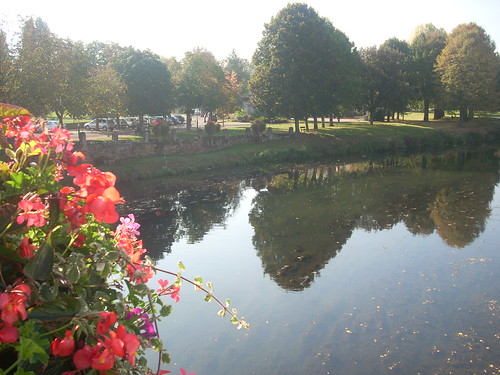
The park from the bridge
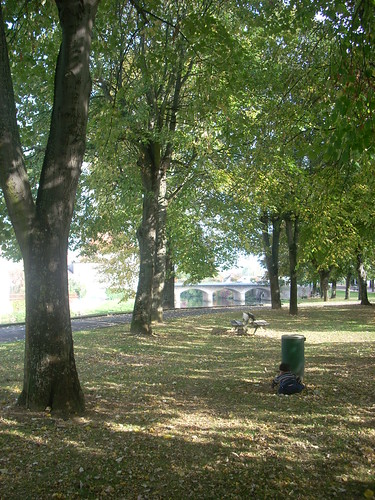
The bridge from the park
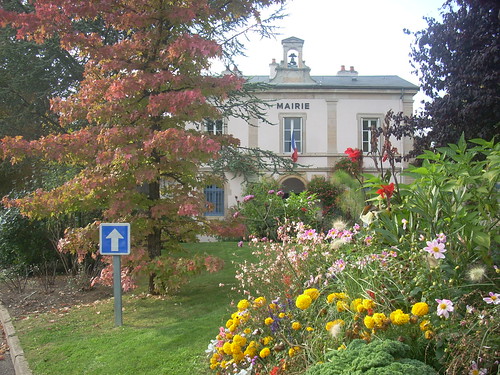
Town Hall, which sits in the center of the park.

Feeding the ducks

Over the rise of grass flows the Canal de Bourgogne, and beyond, hidden behind trees, is the spire of Eglise St. Pierre.

Noticeably thinned out foliage in this photo taken in late October

The park from the bridge

The bridge from the park

Town Hall, which sits in the center of the park.

Feeding the ducks

Over the rise of grass flows the Canal de Bourgogne, and beyond, hidden behind trees, is the spire of Eglise St. Pierre.

Noticeably thinned out foliage in this photo taken in late October
23 October 2007
Notre-Dame de Bon-Espoir
 One of the oldest statues of the Virgin Mary in all of France rests on an altar in Eglise Notre Dame in Dijon. The wooden statue was carved and installed on the altar in the twelfth century. More primitive than beautiful, she is honored as Our Lady of Good Hope, and at least two miracles have been attributed to her intercession, the first occurring on September 11, 1513, the second on the same date in 1944.
One of the oldest statues of the Virgin Mary in all of France rests on an altar in Eglise Notre Dame in Dijon. The wooden statue was carved and installed on the altar in the twelfth century. More primitive than beautiful, she is honored as Our Lady of Good Hope, and at least two miracles have been attributed to her intercession, the first occurring on September 11, 1513, the second on the same date in 1944.In the Fall of 1513, the Swiss had laid siege against the city. On several priests’ initiative, Our Lady of Good Hope was carried on September 11th in a solemn procession through the streets around Notre Dame and petitions offered up for help. Two days later, the Swiss lifted the siege and retreated. Each year afterwards on the same day, a procession was held in her honor, and in 1515, a tapestry was commissioned to celebrate the miraculous deliverance wrought through her care. The tapestry, recently redone, is striking, with a deep red background, Our Lady standing in gigantic posture astride the city walls, the tiny citizens huddling about her gown, and the word TERRIBILIS above it all.
After the statue was torn down and carried off by Jacobins during the French Revolution, the Infant Jesus knocked from her knees and never recovered, Our Lady of Good Hope was found by a Dijonnais and kept safe in a private home. She was brought back to her altar in 1803.

The interior of Notre Dame
Fast forward to the twentieth century, and we find Dijon overrun by the Germans on June 17, 1940. The next day, General de Gaulle made his famed public appeal refusing to recognize the legitimacy of the Vichy regime, and Churchill roused a daunted England to
so bear ourselves that, if the British Empire and its Commonwealth last for a thousand years, men will still say, "This was their finest hour."
It would not be until September 1944, after a successful Allied invasion in Southern France, that German troops began to withdraw towards Dijon to wait for reinforcements from the North. With greater numbers, the Germans seemed successful in resisting American forces, weakened from lack of supplies.
On September 10, the bishop of Dijon, along with its citizens, gathered within Notre Dame Church to plead for help from Our Lady of Good Hope. The very next day—the anniversary of the solemn procession of 1514—French armored divisions linked up with General Patton’s army moving eastward, and the extra reserves overwhelmed the German forces. French soldiers entered the city without a fight. Dijon was free.

A wall of stone plaques in thanksgiving for prayers answered through the intercession of Notre-Dame de Bon-Espoir.
Today, Our Lady of Good Hope can be seen adorned in richly embroidered robes in the chapel to the right of the High Altar at Eglise Notre Dame. A low iron grating separates the chapel, and the altar overflows with baskets of flowers, left by the faithful grateful for her continuing succor.

ô Mère compatissante,
vous avez protégé nos anciens chevaliers, vous avez délivré cette ville des attaques de l'ennemi, vous avez secouru nos pères au milieu de leurs épreuves. Vous exaucez toujours les prières de ceux qui viennent à vous en gémissant. Voyez les peines qui nous affligent et les maux qui nous accablent; ne nous abondonnez pas, jetez sur nous un regard de miséricorde.
Nous venons à vous aujourd'hui en toute confiance, parce que vous êtes Notre-Dame de Bon-Espoir. Réalisez pour nous la promesse que renferme votre beau nom, et nous continuerons toujours de vous servir et de vous aimer. Amen.
Notre-Dame de Bon-Espoir, priez pour nous!
16 October 2007
Blessed Alan (de la Roche) says that a nun who had always had great devotion to the Holy Rosary appeared after death to one of her sisters in religion and said to her: "If I were allowed to go back into my body, to have the chance of saying just one single Hail Mary--even if I said it quickly and without much fervor--I would gladly go through the sufferings of my last illness all over again, in order to gain the merit of this prayer." (Blessed Alan de la Roche, De Dignitate Psalterii, Chapter LXIX) This is all the more compelling because she had been bedridden and had suffered agonizing pains for several years before she died.
--St. Louis de Montfort, The Secret of the Rosary, pp. 49-50
October is the month of the Holy Rosary.
--St. Louis de Montfort, The Secret of the Rosary, pp. 49-50
October is the month of the Holy Rosary.
15 October 2007
The Churches of Dijon

The towers of Notre Dame
Dijon is blessed to have a number of churches (many of them magnificent), and, considering the shortage of priests in Europe, the diocese is surprisingly full of them.
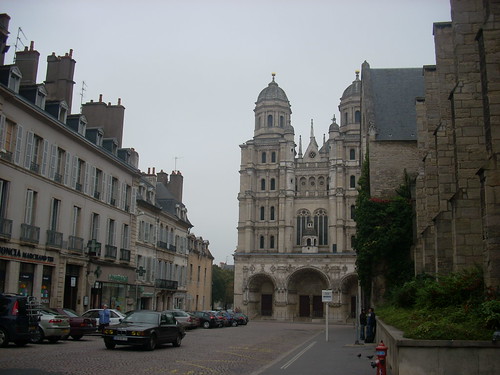
Eglise St. Michel stands in the middle of a square, and on its left is the medieval cemetery where it had its humble beginnings (as a funeral chapel).
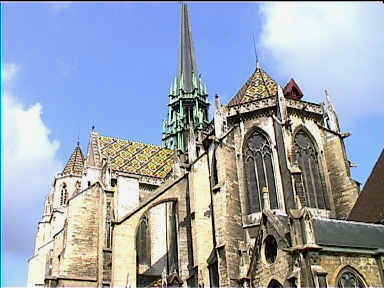
St. Benignus was venerated as a martyr in the third century. A basilica was erected over his tomb in his honor, and a larger structure built in 1272 and completed several decades later. It is the current cathedral of Dijon, Eglise St. Bénigne. St. Benignus's sarcophagus can be seen in the crypt beneath the church, one of the oldest crypts in all of Christendom.
At the cathedral, confessions are heard daily, with twice daily Masses. The recently installed head pastor is striking for his reverence (he also happens to be a member of the Equestrian Order of the Holy Sepulchre) and the associate pastor is my very kind and able confessor.
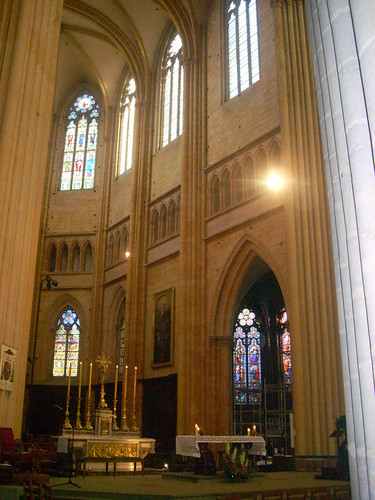
The interior of St. Bénigne (taken after Sunday Mass)
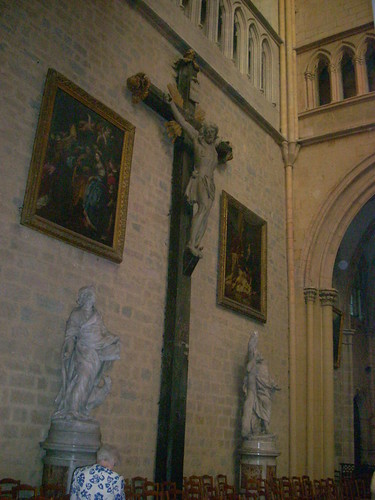
Stunning crucifix. You get an idea of its scale by the woman standing beneath.
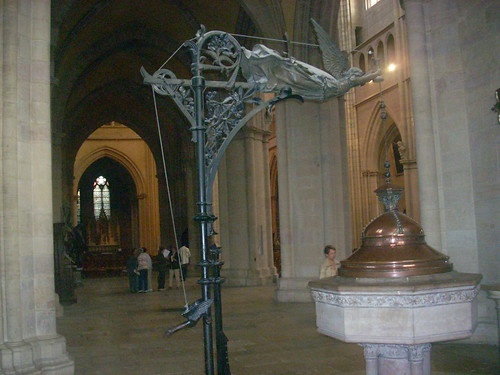
The baptistry (the image doesn’t quite capture its size or beauty).
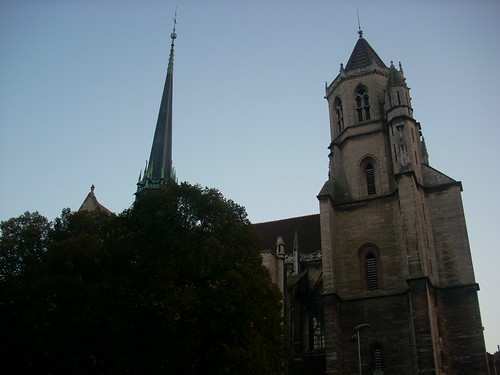
There are a number of other churches I plan on visiting (for instance, the Basilica of St. Bernard of Clairvaux, who was born in Dijon). Photos are forthcoming.
14 October 2007
As some in the Catholic blogosphere are aware, Bill Cork, a convert to Catholicism, swam back across the Tiber this year to rejoin the Seventh Day Adventist Church.
These days, when challenged on a point by a Catholic, he puts forth the argument, as so many Protestants do, that Catholics rely ultimately on the Magisterium, while Protestants rely ultimately on Holy Scripture. I remember once exerting some effort in conversation with a Protestant friend in a café disabusing her of this notion (to which she finally conceded).
As it is, it is a false dichotomy. Both Catholics and Protestants rely on Holy Scripture, and believe in the inerrancy of Scripture. Protestants, however, rely on a different authority to interpret Scripture from that of Catholics, who believe the Magisterium has been commissioned by Christ and led by the Holy Spirit. Protestants must recognize (and admit to) the fact that Scripture must be interpreted. Scripture, as we all know, is hardly clear on many issues (e.g., paedobaptism, abortion, confession, etc.). Interpretation is essential, and any Protestant who thinks otherwise is most sorely and grievously mistaken.
The heart of the question is thus, which authority gives us the correct interpretation of Scripture? For, oh yes, my Protestant friends, each faction of you relies on some authority to interpret Sacred Scripture. For some, it is John Calvin, for others, it is Luther, still for others, it is the teachings of the Seventh Day Adventists. Why, my dear friends across the Tiber, should we believe in your interpretation of Sacred Scripture over ours?
The riposte will surely be, "You should because our teachings accord with Sacred Scripture." Ah, but that is to make a circular argument--and it is the same argument used by every faction of Protestantism. Pro-abortion Lutherans will say that Scripture remains silent on the point, and thus abortion should be left up to the individual. Pro-life Lutherans will point to Psalm 139:14 and like passages to justify their position. Protestants who believe in allowing divorce, and those who do not will quibble over the precise meaning of Matthew 19:3-12 and similar verses. One can set forth a hundred further examples of arguments over the meaning of Scripture--yet we are not any further enlightened as to why one person's argument is any better than the next. Why is Calvin's interpretation more authoritative than Luther's? Again, the only answer given is the circular, very unhelpful one: because one (or the other, depending on whom you speak with) accords better with Scripture.
Fr. Kimel, in a comment thread here, puts it well:
[T]he critical question: When confronted by different readings of Holy Scripture, how does one decide between them? The fact that you believe you are reading Holy Scripture rightly--indeed, so rightly that you are willing to virtually identify your interpretation as the Word of God--does not mean that you are right. It only means that you believe. You may believe that your interpretation of the Bible is clearly and evidently true--but the simple fact remains that believers have disagreed on the content of the apostolic tradition since day two. Protestants themselves cannot agree on the interpretation of Scripture on critical theological and moral questions; yet, mysteriously, they are utterly, utterly, utterly convinced that Catholics are wrong.
It is precisely this inability of Protestantism to negotiate contradictory readings of Holy Scripture--leading to the endless cycle of schism and ecclesiastical re-creation--that has led some of us to question the fundamental hermeneutical commitments of Protestantism, to listen with an open mind and heart to the witness of the Catholic Church, and to seriously consider the possibility that the claims of the Catholic Church may be true. Specifically, it means considering the possibility that God has provided to his Church a final court of appeal for the faithful and authoritative adjudication of moral and theological controversies. Specifically, it means being willing to finally abandon private judgment and to trust in the dogmatic teaching of the bishops of the Church, united in communion with the Bishop of Rome.
And yes, the Catholic Church is 2,000 years old. Schismatics and heretics come and go, yet the Church of Rome abides. It is this fact--not theories, not arguments, not speculations--that finally convinces.
These days, when challenged on a point by a Catholic, he puts forth the argument, as so many Protestants do, that Catholics rely ultimately on the Magisterium, while Protestants rely ultimately on Holy Scripture. I remember once exerting some effort in conversation with a Protestant friend in a café disabusing her of this notion (to which she finally conceded).
As it is, it is a false dichotomy. Both Catholics and Protestants rely on Holy Scripture, and believe in the inerrancy of Scripture. Protestants, however, rely on a different authority to interpret Scripture from that of Catholics, who believe the Magisterium has been commissioned by Christ and led by the Holy Spirit. Protestants must recognize (and admit to) the fact that Scripture must be interpreted. Scripture, as we all know, is hardly clear on many issues (e.g., paedobaptism, abortion, confession, etc.). Interpretation is essential, and any Protestant who thinks otherwise is most sorely and grievously mistaken.
The heart of the question is thus, which authority gives us the correct interpretation of Scripture? For, oh yes, my Protestant friends, each faction of you relies on some authority to interpret Sacred Scripture. For some, it is John Calvin, for others, it is Luther, still for others, it is the teachings of the Seventh Day Adventists. Why, my dear friends across the Tiber, should we believe in your interpretation of Sacred Scripture over ours?
The riposte will surely be, "You should because our teachings accord with Sacred Scripture." Ah, but that is to make a circular argument--and it is the same argument used by every faction of Protestantism. Pro-abortion Lutherans will say that Scripture remains silent on the point, and thus abortion should be left up to the individual. Pro-life Lutherans will point to Psalm 139:14 and like passages to justify their position. Protestants who believe in allowing divorce, and those who do not will quibble over the precise meaning of Matthew 19:3-12 and similar verses. One can set forth a hundred further examples of arguments over the meaning of Scripture--yet we are not any further enlightened as to why one person's argument is any better than the next. Why is Calvin's interpretation more authoritative than Luther's? Again, the only answer given is the circular, very unhelpful one: because one (or the other, depending on whom you speak with) accords better with Scripture.
Fr. Kimel, in a comment thread here, puts it well:
[T]he critical question: When confronted by different readings of Holy Scripture, how does one decide between them? The fact that you believe you are reading Holy Scripture rightly--indeed, so rightly that you are willing to virtually identify your interpretation as the Word of God--does not mean that you are right. It only means that you believe. You may believe that your interpretation of the Bible is clearly and evidently true--but the simple fact remains that believers have disagreed on the content of the apostolic tradition since day two. Protestants themselves cannot agree on the interpretation of Scripture on critical theological and moral questions; yet, mysteriously, they are utterly, utterly, utterly convinced that Catholics are wrong.
It is precisely this inability of Protestantism to negotiate contradictory readings of Holy Scripture--leading to the endless cycle of schism and ecclesiastical re-creation--that has led some of us to question the fundamental hermeneutical commitments of Protestantism, to listen with an open mind and heart to the witness of the Catholic Church, and to seriously consider the possibility that the claims of the Catholic Church may be true. Specifically, it means considering the possibility that God has provided to his Church a final court of appeal for the faithful and authoritative adjudication of moral and theological controversies. Specifically, it means being willing to finally abandon private judgment and to trust in the dogmatic teaching of the bishops of the Church, united in communion with the Bishop of Rome.
And yes, the Catholic Church is 2,000 years old. Schismatics and heretics come and go, yet the Church of Rome abides. It is this fact--not theories, not arguments, not speculations--that finally convinces.
11 October 2007
Clos des Carmélites
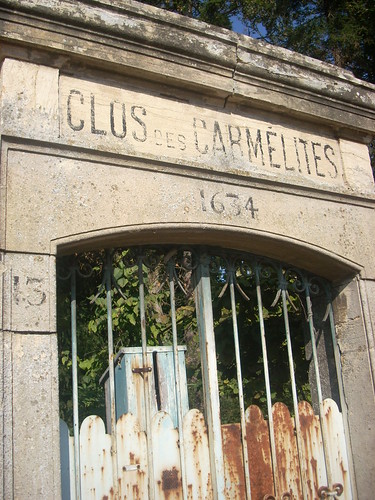
Three blocks from our apartment one can find a seventeenth century orchard once belonging to the Carmelites of Dijon. I discovered it on a stroll with my children towards the Etang Royal (Royal Pond, now a local fishing spot).
There isn't much information on the old orchard, only that it was owned by the Carmelites, along with a few other buildings in the vicinity. One assumes that during the Revolution the government seized the property, as it had so many others belonging to Carmel. The enclosure, which goes on for many blocks, is now surrounded by a new subdivision (aptly called Carmélites), and from outside the stone wall one can see the tops of trees sprawling wildly and unkempt.
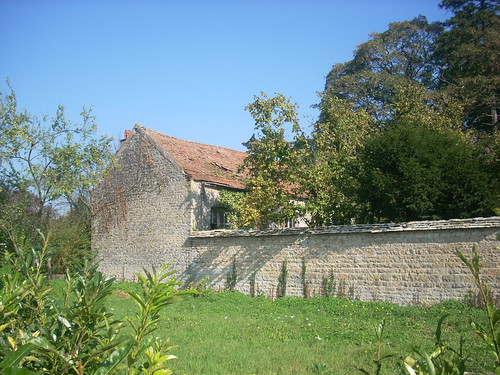
Part of the enclosure from the outside.
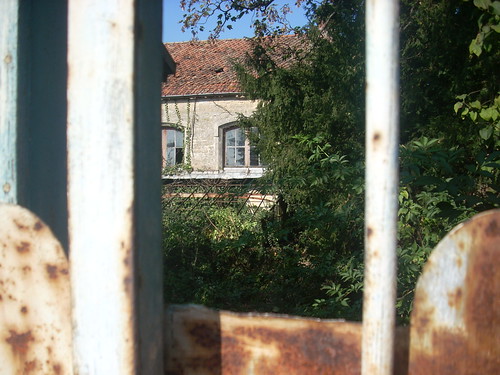
Within, nothing but overgrowth and a crumbling building.

Another section of the wall, with a blocked-up window.
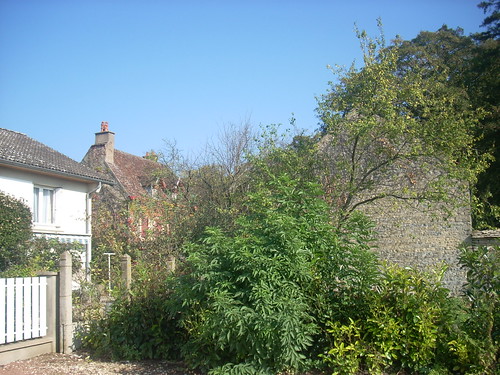
According to this document, the town has decided to turn the orchard into a park--which means the unfortunate soul inhabiting the house on the grounds (the brown brick home seen in the background) will be looking for new lodgings soon.
09 October 2007
Sunday Excursion
The family took a leisurely stroll to Parc Colombière Sunday afternoon.

The path along the L'Ouche
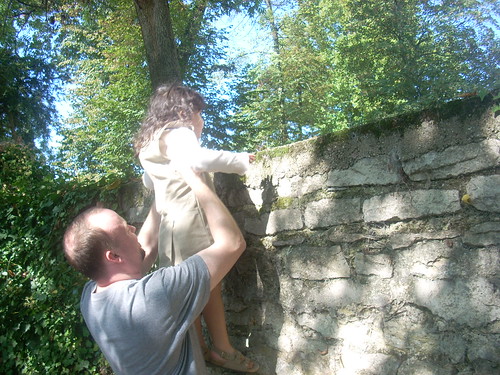
Marie gets a lift.
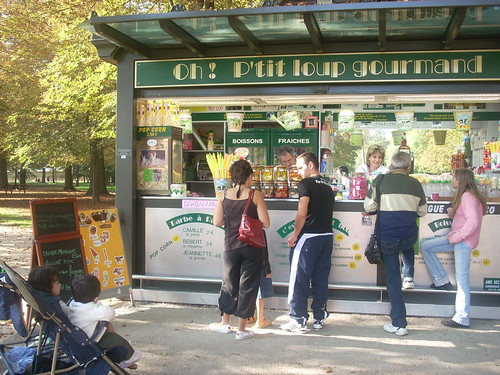
Taking a break for l'hot dog and a lollipop, the kids sit patiently in their double stroller.
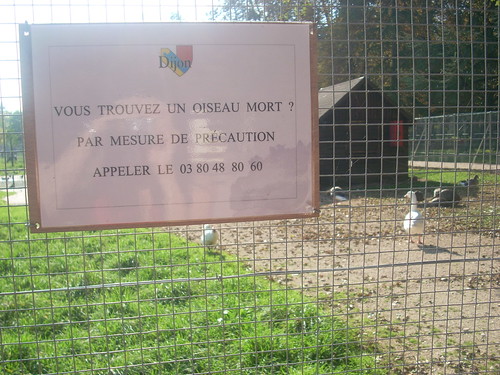
The city keeps all sorts of livestock in the park, including geese and chicken (couldn't spot any Bresse cockerel). Needless to say, after reading the sign, we didn't lounge about the fowl too long.

French children congressing at one of the dozen or so playgrounds. Michel wanders off in the foreground.

Marie, her head wreathed in light, ponders the ontological implications of life as a young Catholic.

The path along the L'Ouche

Marie gets a lift.

Taking a break for l'hot dog and a lollipop, the kids sit patiently in their double stroller.

The city keeps all sorts of livestock in the park, including geese and chicken (couldn't spot any Bresse cockerel). Needless to say, after reading the sign, we didn't lounge about the fowl too long.

French children congressing at one of the dozen or so playgrounds. Michel wanders off in the foreground.

Marie, her head wreathed in light, ponders the ontological implications of life as a young Catholic.


